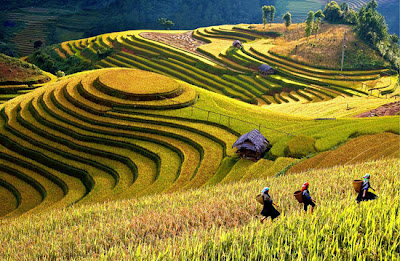Hanoi is home to several lakes, of which Hoan Kiem Lake
between the Old Quarter and the French Quarter is the most famous. However,
there are several other lakes in Hanoi, including West Lake, Thien Quang Lake,
and Truc Bach Lake. When visiting Hanoi, be sure not to miss its lakes, which
are one of the most unique features of this bustling capital.
Hoan Kiem Lake
Hoan Kiem Lake is a relatively small lake, with its banks
turned into a lovely park. “Ho Hoan Kiem” translates literally as “Lake of the
Restored Sword”. The lake takes its name from an ancient legend, in which the
emperor Le Loi returned a magic sword to the Golden Turtle God who resided in
the lake. Today, the lake holds a small pagoda in its centre known as Turtle
Tower (or Thap Rua) in honour of the sword's return.
Besides the legend, real soft-shell turtles can sometimes
be spotted in the lake. These large turtles are critically endangered animals,
so spotting one is a real treat.
Near Hoan Kiem's northern shore is Jade Island, home to
the Jade Mountain Temple (or Ngoc Son Temple). Erected in the eighteenth
century to honour a thirteenth century military leader, you can reach the
temple by crossing a bright red wooden bridge.
The park around Hoan Kiem Lake is usually filled with
street vendors, old men playing chess, and, if you get to the park early enough
in the morning, locals beginning their day with Tai Chi.
West Lake
West Lake (or Ho Tay) is located in the very centre of
Hanoi. The largest lake in Hanoi, its shore runs 17 km. Surrounding West Lake
are well-tended gardens, high-end hotels, and villas. A popular place for
recreation, West Lake has long been a central part of life in Hanoi. The
Vietnamese have several legends surrounding the creation West Lake, including a
story of an evil, nine-tailed fox who wanted to harm local residents, and a
giant whose bronze bell brought a rampaging golden buffalo to the area. In
actuality, however, the lake was formed when the red river changed its course.
Throughout history, West Lake has been a key feature of
Hanoi. Kings built palaces and temples around the lake, and today's “modern
palaces” of high-end villas, hotels, and restaurants continue that tradition.
Points of interest for history buffs are the Tran Quoc Pagoda (the oldest
pagoda in all of Vietnam), and the Quan Thanh Temple (one of ancient Hanoi's
Four Sacred Temples).
Thien Quang Lake
Not far from West Lake, Thien Quang, which means
“Buddha's Light”, was named for a village located along the southeastern corner
of the five hectare lake. Other villages also surrounded the lake, but as Hanoi
grew, these villages were absorbed by the city. Unfortunately, the French
filled in part of the lake in order to build more streets in the 1930s,
transforming the lake into its present size and shape. The traditional village
populations at that time were displaced, most of them moving to the western
side of the lake (today, 31 – 33 Tran Binh Trong Street).
Also known as “Halair Lake” and “Halais Lake”, Thien
Quang today occupies a relatively quiet area, surrounded by a park with walking
trails. Visitors might see young boys fishing with bamboo poles along the
lake's edge.
Truc Bach Lake
Students of the American Vietnam War may know Truc Bach
Lake as the place where the American 2008 presidential candidate and Arizona
senator, John McCain, was shot down. McCain parachuted from his plane into the
lake and nearly drowned. A group of Vietnamese men pulled him from the lake, at
which point he was mauled by a mob and made a prisoner of war. To this day, a
monument erected in celebration of this event stands on the western shore of
the lake.
Built in the 1600s when a narrow dyke was constructed in
order to divide West Lake for the purpose of raising fish, Truc Bach Lake is
dotted with historically significant sites. The Vien Truc Lam palace is one of
these, which was originally a place of worship, and later became a prison for
“errant ladies”. The ladies living in the prison were forced to weave, and the
silk fabric they produced there became famous throughout Hanoi. On the
southwestern corner is the Holy Mandarin Temple, and in the east is Chau Long
pagoda. An Tri temple is also nearby.
Hanoi's lakes, along with the parks and historical
landmarks surrounding them, are definitely worth a visit as you explore Hanoi.
If possible, try to make it to the lakes early one morning as the sun is
rising. West Lake and Hoan Kiem Lake especially are very beautiful as the sun
comes up, and a beer on West Lake watching the sun set is a great way to end a
hard day's exploring.
.jpg.bmp)





















